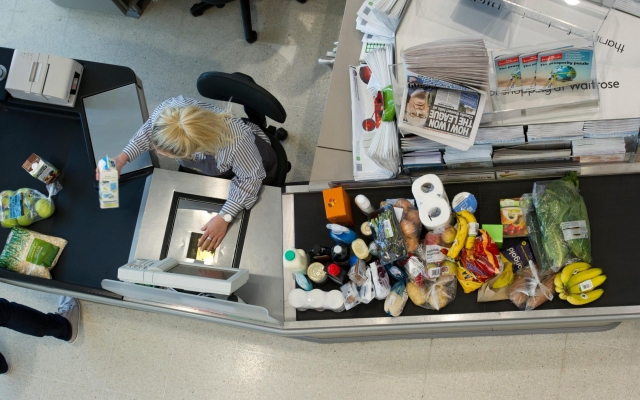 Staff are under attack as part of the latest cost-cutting measures, but many say they are crucial to maintaining the supermarket's reputation. Photo: Simon Dawson/Bloomberg News
Staff are under attack as part of the latest cost-cutting measures, but many say they are crucial to maintaining the supermarket's reputation. Photo: Simon Dawson/Bloomberg News
When Waitrose staff opened an email from retail director Tina Mitchell last week, few were surprised to discover it was about cost cutting.
“Problems challenges we face as a business continue unabated. «Mitchell wrote. “Waitrose is one of the least productive grocers in the UK.”
Supermarket employees will have to become more flexible with their working hours, she says, after years of the grocer having either too much or too little product. workers on duty at any given time.
“For every full-time equivalent partner, we make a loss of £400 annually,” Mitchell said. This was unacceptable at a time when the parent company, John Lewis Partnership, was suffering heavy losses.
As well as promoting more flexible working arrangements, Waitrose has told staff it is preparing to scrap night shifts at 18 stores. Workers in these roles are «at risk of forced redundancy.»
In 17 other stores, Waitrose has launched consultations on reducing staff working hours and will offer staff voluntary redundancy.
Collectively, these changes could saving the supermarket £50 million a year.
 Dame Sharon White is under pressure to demonstrate her recovery plan is working ahead of JLP's half-year results. Photo: Jason Alden/Bloomberg Finance LP
Dame Sharon White is under pressure to demonstrate her recovery plan is working ahead of JLP's half-year results. Photo: Jason Alden/Bloomberg Finance LP
Cost cuts come ahead of a crucial set of half-year results for John. Lewis Partnership this week as chairman Dame Sharon White faces pressure to show her turnaround plan is delivering results.
In March this year, Dame Sharon unveiled plans to cut the costs of the partnership, which owns John Lewis and Waitrose, by £600 million on top of the £300 million already cut.
This was followed by a turnaround plan. a £230m loss last year after the business was hit by inflation and the cost of living crisis. John Lewis has hired turnaround expert Nish Kankiwala to help him in his new role as CEO.
Much of the cost cutting so far has been focused on department stores.
March results show John Lewis saved £47 million last year and Waitrose made £29 million. The smaller savings come despite Waitrose posting stronger sales than its stablemate, suggesting more fat may have to be cut.
«John Lewis department stores have really gone through this over the last few years,» says one. former director of the partnership. «Waitrose is late to the party, but I think we'll see from there.»
Particular attention is paid to the fact that productivity at Waitrose is deteriorating faster than at John Lewis. Sales at supermarkets fell by 3%, but at department stores they remained unchanged. Trading profits at Waitrose are also falling faster.
Its market share fell from 4.6% to 4.4% last year and was down from 5.3% in 2017, according to Kantar. Customers who come in spend less: Waitrose said earlier this year that shoppers were putting less in their baskets amid a sharp fall in the cost of living.
Waitrose has turned to consultants to help supermarket boss James Bailey identify areas where cash can be freed up. Photo: Tom Stockill/CAMERA PRESS
In March, The Telegraph reported that Waitrose had brought in consultants from US group Bain to help the supermarket boss James Bailey. identify areas where you can free up money. Suggestions included reducing the variety of products on shelves, meaning less product duplication.
The focus now is on solving the problem of inflated staff costs. Mitchell told workers last week that Waitrose's operating model was «complex, slow, inflexible and inaccessible». The supermarket estimates it spends around £855m a year on staff pay, the second biggest expense after shares.
Chiefs are understood to be keeping an eye on how rival supermarkets have improved productivity in recent years their teams. focusing on how schedules have become more flexible.
Companies such as Asda, Sainsbury's and Tesco have already made changes to employment contracts, taking measures such as cutting bonuses and requiring employees to have more flexible working hours.
Identify what needs to change, — that's one thing. but doing it is another matter entirely.
Waitrose is different from other grocers. Employees, known as partners, have an interest in the business and collectively own it. Reform requires a greater degree of consensus than elsewhere.
Some insiders fear changes to staff working hours could undermine the Waitrose brand.
“The problem with Waitrose (and John Lewis for that matter) is that people go to these companies based on the quality of their customer experience,” says one former executive.
By By changing how and when employees work, “you risk eliminating the very reason people go there,” they say. “The whole point of the partnership model is that you invest in people, so they provide better customer service.”
 Some insiders fear the changes to staff working hours could undermine the Waitrose brand, known for its high-quality customer service. Photo: Jonathan Buckmaster/Alamy Stock Photo
Some insiders fear the changes to staff working hours could undermine the Waitrose brand, known for its high-quality customer service. Photo: Jonathan Buckmaster/Alamy Stock Photo
At an internal partnership forum, staff are concerned that reduced night shifts at some stores could mean less stock availability when branches open in the morning. Others were upset by Mr Mitchell's claim that each Waitrose worker costs the business £400 a year, with one employee complaining people feel «undervalued».
Bosses hope staffing changes Waitrose timetables will improve the customer experience. Last week, Mitchell told employees: “If we do this right, it will be a nicer place to work.”
But, as one partner asked: “The question is where we are at the moment — and why it seems , are we always wrong?”
Observers are eagerly awaiting progress in Mrs Sharon's efforts to change the situation. Shore Capital analyst Clive Black says the partnership should show «evidence that the program is moving in the right direction» in its half-year results on Thursday.
Although John Lewis is not listed on the stock exchange and is instead co-owned On the part of its employees, interest in the city remains high, not least among banks and bondholders.
At the end of the last financial year, the partnership's net debt stood at around £1.7bn, including £350m payable. are due to be repaid by January 2025.
Moreover, John Lewis floated the idea of bringing in an external investor within the company, although Dame Sharon has since played down the idea.
Black says: “ We should see it start to deliver results in terms of revenue, profit and cash flow.»
Typically the first half of John Lewis's financial year is tougher than the second, which gets a boost from the festive period. This means the figures may still appear challenging, although they are expected to emerge.
Meanwhile, it will be increasingly difficult to find new areas that can be implemented in the £600 million cost-cutting plan more difficult.
Richard Hyman, a retail consultant, says: «There has been a lot of pressure on the situation for many years, so few retailers have large costs that they can easily cut without negatively impacting their ability to generate revenue and profit.»< /p>
For John Lewis, which has already shed hundreds of millions of pounds, the low hanging fruit has already been trimmed.
John Lewis Partnership insists the changes at Waitrose are aimed at delivering «the very best service for our customers, and that means having the right number of partners doing the right tasks at the right time.»
A Waitrose spokesman said: «To achieve this, we are asking some partners in our stores to change their working hours and are proposing to end night shifts in a small number of stores . We do not take this lightly and will support our partners through any changes.”
The supermarket is not expected to ask workers to agree to any changes to their contracts if it would negatively impact their overall hours , which they worked per week, or their contract salary.























































Свежие комментарии